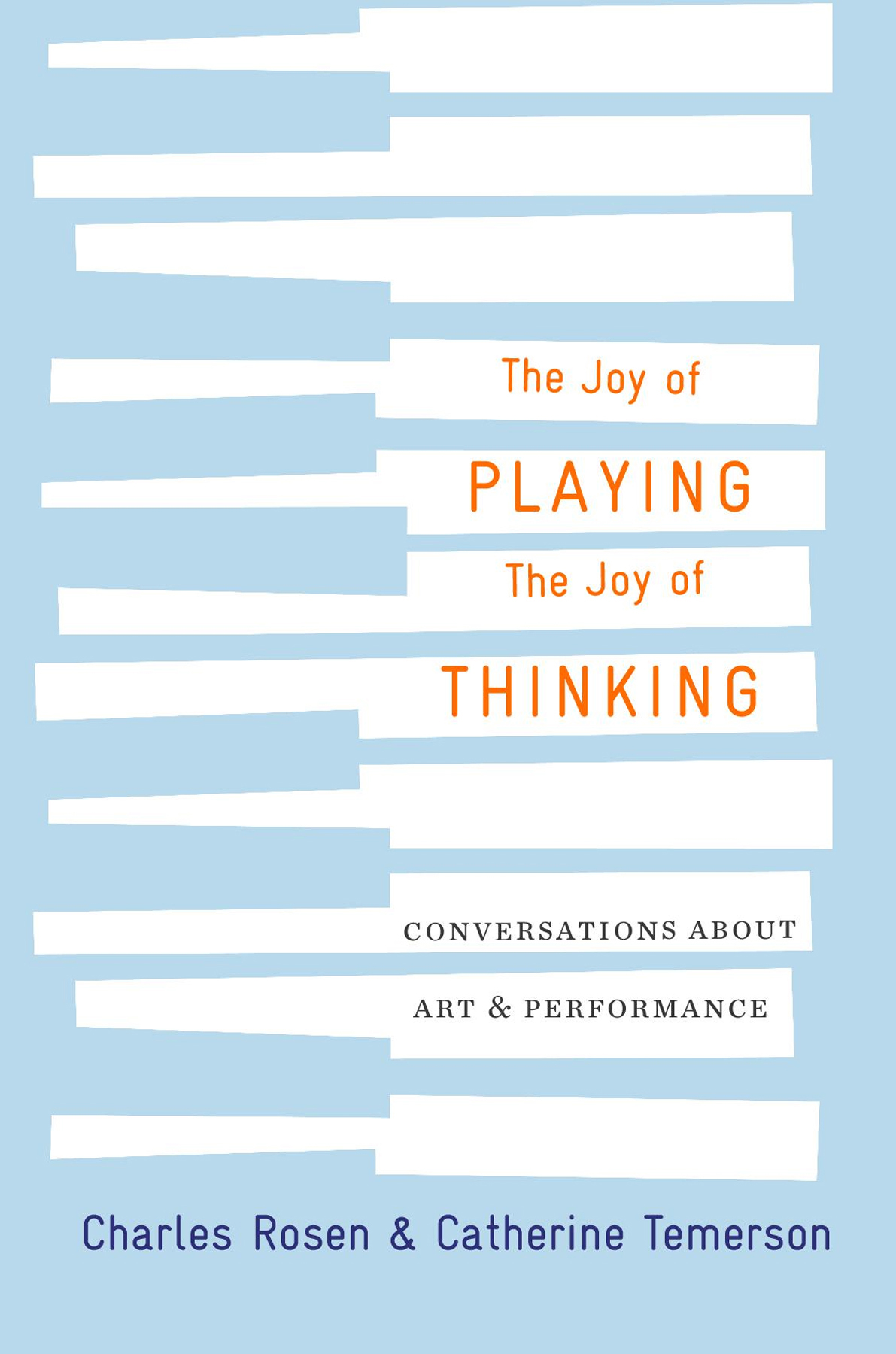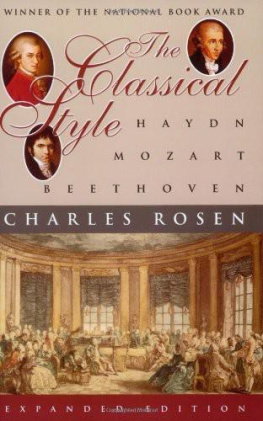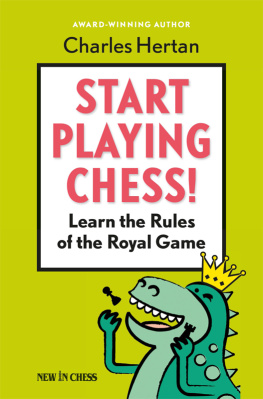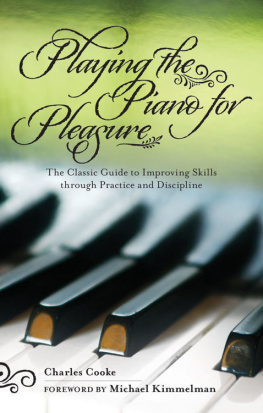Charles Rosen - The Joy of Playing, the Joy of Thinking: Conversations about Art & Performance
Here you can read online Charles Rosen - The Joy of Playing, the Joy of Thinking: Conversations about Art & Performance full text of the book (entire story) in english for free. Download pdf and epub, get meaning, cover and reviews about this ebook. publisher: Harvard University Press, genre: Detective and thriller. Description of the work, (preface) as well as reviews are available. Best literature library LitArk.com created for fans of good reading and offers a wide selection of genres:
Romance novel
Science fiction
Adventure
Detective
Science
History
Home and family
Prose
Art
Politics
Computer
Non-fiction
Religion
Business
Children
Humor
Choose a favorite category and find really read worthwhile books. Enjoy immersion in the world of imagination, feel the emotions of the characters or learn something new for yourself, make an fascinating discovery.

- Book:The Joy of Playing, the Joy of Thinking: Conversations about Art & Performance
- Author:
- Publisher:Harvard University Press
- Genre:
- Rating:3 / 5
- Favourites:Add to favourites
- Your mark:
- 60
- 1
- 2
- 3
- 4
- 5
The Joy of Playing, the Joy of Thinking: Conversations about Art & Performance: summary, description and annotation
We offer to read an annotation, description, summary or preface (depends on what the author of the book "The Joy of Playing, the Joy of Thinking: Conversations about Art & Performance" wrote himself). If you haven't found the necessary information about the book — write in the comments, we will try to find it.
The Joy of Playing, the Joy of Thinking: Conversations about Art & Performance — read online for free the complete book (whole text) full work
Below is the text of the book, divided by pages. System saving the place of the last page read, allows you to conveniently read the book "The Joy of Playing, the Joy of Thinking: Conversations about Art & Performance" online for free, without having to search again every time where you left off. Put a bookmark, and you can go to the page where you finished reading at any time.
Font size:
Interval:
Bookmark:

The Joy of Playing, the Joy of Thinking
Conversations about Art & Performance
CHARLES ROSEN
CATHERINE TEMERSON
Translated by Catherine Zerner
THE BELKNAP PRESS OF HARVARD UNIVERSITY PRESS
Cambridge, Massachusetts
London, England
2020
Copyright 2020 by the President and Fellows of Harvard College
All rights reserved
First published as Plaisir de jouer, plaisir de penser; Prface dIsrael Rosenfield,
Copyright Manuella ditions, Paris, 2016
ISBN original: 978-2-917217-78-8
Cover design: Tim Jones
Cover image: Getty Images
978-0-674-98846-0 (cloth)
978-0-674-24978-3 (EPUB)
978-0-674-24979-0 (MOBI)
978-0-674-24980-6 (PDF)
The Library of Congress has cataloged the printed edition as follows:
Names: Rosen, Charles, 19272012, author. | Temerson, Catherine, interviewer. | Zerner, Catherine, translator.
Title: The joy of playing, the joy of thinking : conversations about art and performance / Charles Rosen, Catherine Temerson ; translated by Catherine Zerner.
Other titles: Plaisir de jouer, plaisir de penser. English
Description: Cambridge, Massachusetts : The Belknap Press of Harvard University Press, 2020. | First published as Plaisir de jouer, plaisir de penser. Paris : Editions Xanadu-Manuella Vaney, 2016. | Includes bibliographical references.
Identifiers: LCCN 2020016347
Subjects: LCSH: Rosen, Charles, 19272012Interviews. | PianistsUnited StatesInterviews. | Musicologists United StatesInterviews. | MusicPhilosophy and aesthetics.
Classification: LCC ML417.R733 A5 2020 | DDC 780.92 [B]dc23
LC record available at https://lccn.loc.gov/2020016347
Almost all the best-known works of Johann Sebastian Bach, for exampleThe Well-Tempered Keyboard, the Goldberg Variations, the Partitas, the Italian Concerto, the Art of Fugueare educational, models of composition to be studied and played at home: the kind of public concert at which they could be played did not exist during Bachs lifetime, and he could never have envisaged a concert performance of any of them. In fact, public performance of most of these works is largely an invention of the twentieth century.
Charles Rosen, Critical Entertainments
I F MUSIC WAS composed for private concertsBach played for himself, as Charles has writtenCatherine and Charles played for themselves and their own duo. They gave a series of private concerts, of private discussions and private dinners on literature, architecture, science, and, of course, music. They both enjoyed writing. And Catherine enjoyed translating as well. Catherine suggested to Charles that they do a book together, and Charles said he would love to do the book but only with Catherine. Catherine knew Charles and the circle of musicians that were close friends of her familyElliott Carter, Arthur Berger, Dimitri Mitropoulos, among otherssince her childhood. Her mother was a painter and her father a violinist. Her mother prepared superb dinners, and her father played sonatas with Charles. They lived for music.
But music was not their only bond. Catherine had a doctorate in comparative literature from New York University and Charles a doctorate in French literature from Princeton University. Catherines father was French, and she was raised in France and had a bilingual education. Her mother was Russian, and she spoke Russian and studied Russian literature at Sarah Lawrence College and Harvard University. Charles had visited France on a Fulbright.
Their private concerts were a pleasure in themselves, the preparation of another kind of representationa public one. There was no better public than Catherine. She was not passive. She discussed things with Charles and helped his ideas take shape. One could make an analogy with the music of Elliott Carter and Cubist paintings. They both depend on multiple points of view. It was these multiple points of view that created the pleasure of discussions, writing and playing.
As in Schuberts and Schumanns lieder or the sonata Les Adieux of Beethoven, where the past and present are represented simultaneously, there was in the dialogues of Catherine and Charles the presence of musicians and artists they had known and who came to life in their discussions. These dialogues are a work unto themselves and they resonate with an enlarged conception of music; they give two pleasures: one muscular and the other intellectual.
Charles has written on the Double Concerto of Elliott Carter: When the work was written, playersat least in privatewere taken aback by the lack of a central rhythm that would have made ensemble playing easier, just as painters felt a curious anxiety with the loss of central point of view in Cubist paintings. A multiplicity of points of view has become central to the artistic imagination of the twentieth century. It is the multiple points of view, the wonderful synthesis of literature, science, painting, and, of course, music that makes the book of Catherine and Charles a joy, a pleasure to read and think about.
T HIS LITTLE BOOK is a conversation about music between two good friends intended for an audience of interested non-professionals like myself. I agreed to undertake its translation into English because Charles Rosen was a dear friend, and I was accustomed to listening to him talk about ideas that also appear in this book. Charles habitually wrote in his head and often spoke whole paragraphs of his current project over tea or at the dinner table. I wanted to convey something of his voice while remaining faithful to his and Catherines text. Charles always meant what he said in the way he said it, and he could be quite fierce. Luckily, I had Henri Zerners guidance throughout and am deeply grateful. The task would have been impossible without him.
The two French editions had summary bibliographies and a brief discography of Charless recordings then available in France. Both have been expanded to include as much existing material as possible so that readers can find their way to Charless other writings and recordings.
I wish to thank Harvard University Press for their support and careful editing.
Catherine Zerner
CHARLES ROSEN
Pianist Charles Rosen (19272012) was a child prodigy, entering the Juilliard School of Music when he was six years old. At eleven, he became a pupil of the celebrated pianist Moriz Rosenthal, himself a former student of Franz Liszt, and began his international career.
A well-known musicologist and lecturer at Harvard (the Norton Lectures), he also taught at Oxford University and the University of Chicago. He is the author of numerous books and articles on music including The Frontiers of Meaning: Three Informal Lectures on Music and The Romantic Generation (the Charles Eliot Norton Lectures). The Classical Style received the National Book Award and was awarded the Edison Prize for his body of work. He held honorary doctorates from the universities of Cambridge, Leeds, Durham, Bristol, and Trinity College, Dublin. President Obama awarded him the National Humanities Medal on February 13, 2012.
CATHERINE TEMERSON
Catherine Temerson (19442015) was the literary director of the Ubu Repertory Theater of New York. She held a masters degree in Russian literature from Harvard University and a PhD in comparative literature from New York University. Completely bilingual in English and French, she published
Font size:
Interval:
Bookmark:
Similar books «The Joy of Playing, the Joy of Thinking: Conversations about Art & Performance»
Look at similar books to The Joy of Playing, the Joy of Thinking: Conversations about Art & Performance. We have selected literature similar in name and meaning in the hope of providing readers with more options to find new, interesting, not yet read works.
Discussion, reviews of the book The Joy of Playing, the Joy of Thinking: Conversations about Art & Performance and just readers' own opinions. Leave your comments, write what you think about the work, its meaning or the main characters. Specify what exactly you liked and what you didn't like, and why you think so.





